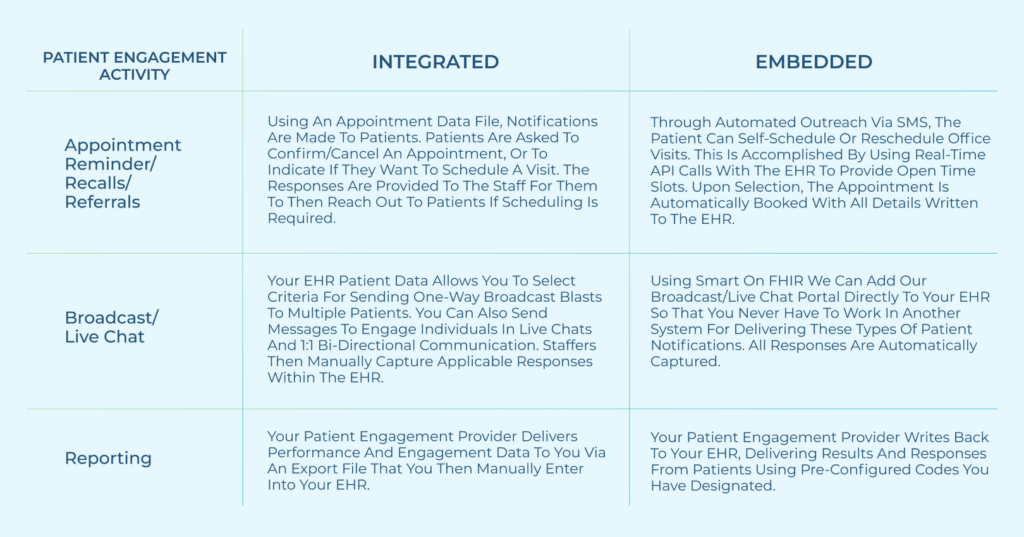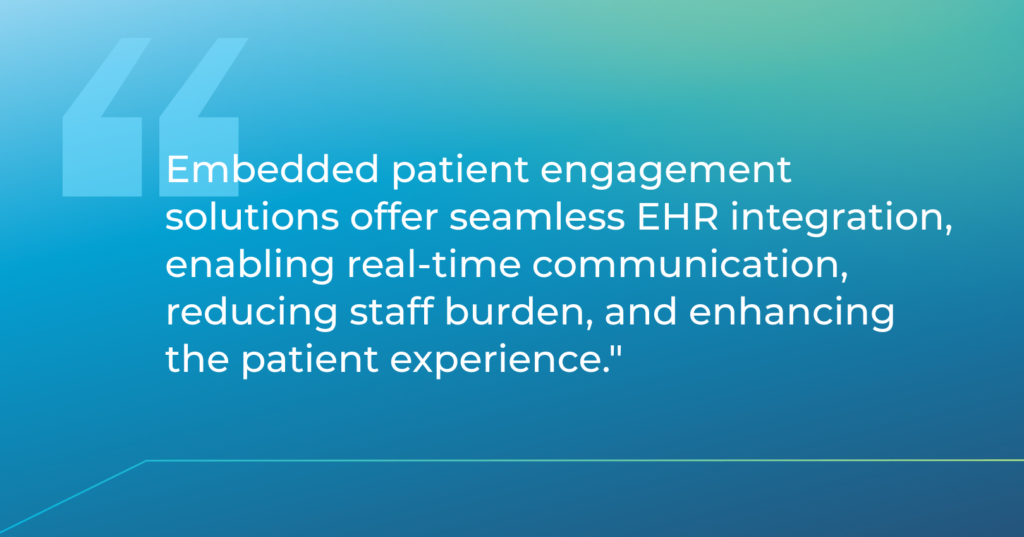When patients miss their vaccinations, it leaves both them and their communities exposed to preventable…

Embedded vs. Integrated: Which Patient Engagement Solution Is Right for You?
When considering the level of interplay with your Electronic Health Record (EHR), you’ll find patient engagement solutions that are integrated with your EHR and others that are embedded. While many patient engagement providers claim to be integrated, this can mean many things. So, what’s the difference, and why does it matter?
Take note that three core attributes often define the value of a patient engagement solution:
- Ease of training and adoption.
- How it works with your EHR.
- Quality of messaging: channels, languages, and tone.
Of these, EHR interplay is frequently the least understood, and yet it’s one of the most critical. Before diving into the technical distinctions, let’s explore why more healthcare organizations are choosing embedded solutions over integrated ones.
How Does an Integrated Patient Engagement Solution Work?
Integrated patient engagement systems combine multiple healthcare functions into a single application. These systems connect with EHRs through specific data bridges that staff members activate when needed.
Most integrated systems use one of three connection methods:
- File exchange
- HL7 protocols
- Application programming interfaces (APIs)
Each method has its strengths and limitations. Regardless of the connection type, patient engagement activities start within the engagement platform itself. Information sharing between the platform and EHR typically requires manual steps by staff, with the level of automation depending on the software’s capabilities.
Unlike standalone tools, integrated solutions reduce duplicate data entry and help maintain consistent patient information across systems. Staff can access relevant patient details without switching between multiple programs.
Working of an Embedded Patient Engagement Solution
Embedded patient engagement systems exist directly within healthcare hardware or platforms. These systems run on specialized code designed for specific devices with particular processing capabilities and memory constraints.
Healthcare organizations typically implement embedded solutions through API packages that connect patient engagement platforms to EHRs. This connection happens automatically without staff intervention.
Advanced embedded solutions combine API technology with standards like Smart on FHIR to:
- Create direct pathways to EHR data.
- Allow chat functions to appear within the EHR interface.
- Update information across systems without manual steps.
Unlike integrated systems, where staff must activate connections, embedded solutions maintain constant communication between platforms. Staff see patient engagement data directly in their EHR screens, while patients interact with a system that accesses up-to-date medical information.
This embedded approach eliminates duplicate data entry and reduces the risk of outdated information appearing in either system.
How Embedded Solutions Offer a Frictionless Experience
Healthcare entities benefit from truly embedded patient engagement solutions that provide frictionless, closed-loop workflows. They write to and from EHRs, eliminating the need for manual information sharing. Below are three examples of the two-phase approach that leading patient engagement providers offer.
Example #1 – Rescheduling
Instead of asking patients if they want to reschedule, then making the patient call the office, or setting up a trigger for the office to call the patient, an embedded solution allows the patient to reschedule directly within the text message without any interaction from staff. The patient’s response is written directly back to the EHR.
Example #2 – Live Connect
Instead of notifying a patient to call the office to set up a referral/recall appointment, the embedded solution connects them in real-time to the office’s call center. This can be configured to accommodate shift hours and staff breaks. Both the patient and the healthcare organization’s staff can connect when it is convenient for them.
Example #3 – Reporting
Instead of making staff log in to a separate customer application to retrieve results from notification outreaches, embedded solutions enable staff members to use their EHR’s existing reporting tools to configure and pull the notification results from the patient engagement platform. This consolidation of data ensures the EHR remains the single source of truth. Plus, you are eliminating the need to maintain duplicate databases.
Embedded vs. Integrated: The Differences
While the terms “embedded” and “integrated” are often used interchangeably in healthcare organizations, they represent two fundamentally different approaches to how patient engagement tools interact with the EHR.
The differences impact more than just task automation. They influence usability, staff efficiency, data accuracy, and most importantly, patient experience.
Let’s compare how common patient engagement activities are handled in integrated versus embedded models:

Which Patient Engagement Solution Is Better for You?
Imagine giving patients what they want: fast answers, convenient scheduling, and real-time updates without adding more pressure to your staff. That’s the promise of TeleVox’s SMART Agent, an AI-powered, EHR-embedded solution built to transform patient engagement from the front door onward.
We’ve designed our tech to be not just intelligent, but also responsible for healthcare organizations. It delivers HIPAA-compliant, omnichannel support through voice, text, and chat, helping patients self-schedule, reschedule, or get answers to routine questions without staff intervention.
And because it’s embedded directly within your EHR, it eliminates data silos and manual follow-ups, all while enhancing the patient experience with a human-like touch.
If you’re still toggling between applications, manually transferring patient data, or struggling with disconnected workflows, it’s time to rethink your patient engagement strategy. Schedule a demo today, and discover for yourself why TeleVox should be your go-to embedded healthcare platform.




